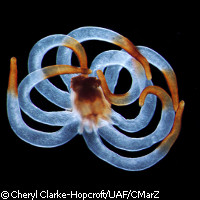Deep sea treasures underpin life on Earth
Scientists from across the globe are piecing together information on tiny microbes and other hard-to-see species that live at the bottom of the sea and are connected to almost all other life on the planet. The study is part of Census of Marine Life, one of the biggest international collaborations ever undertaken in the history of science, with the participation of more than 2,000 researchers from over 80 countries. Marine microbes are tiny ocean creatures that constitute up to 90% of all ocean biomass. The microbes, which include zooplankton, larvae, burrowers and other members of the microbe family that live on the sea floor, are fundamental to our planet's machinery, and studying them provides us with information on the Earth's food chain, carbon cycle and other elementary functions. In the current study, scientists are conducting an inventory of these creatures, identifying species, quantities, and locations, and understanding the role they perform. The research represents 4 of the 14 projects that make up the Census of Marine Life, an enormous 10-year scientific undertaking into marine life past, present and future that has been supported by the EU through individual project grants. The four Census projects focusing on 'hard-to-see' sea species include the International Census of Marine Microbes (ICoMM), the Census of Marine Zooplankton (CMarZ), the Census of the Diversity of Abyssal Marine Life (CeDAMar), and the Biogeography of Deep-Water Chemosynthetic Ecosystems (ChEss). Some 300 hundred scientists are involved, and when the whole Census initiative comes to an end in October 2010, almost 300 expeditions will have been amassed under these 4 studies alone. 'In no other realm of ocean life has the magnitude of Census discovery been as extensive as in the world of microbes,' said Dr Mitch Sogin of the Marine Biological Laboratory in Woods Hole in the US, which is working with the Royal Netherlands Institute for Sea Research in the Netherlands under ICoMM. 'Scientists are discovering and describing an astonishing new world of marine microbial diversity and abundance, distribution patterns and seasonal changes,' added Dr Sogin. But this wasn't always the case. Up until Census, little was known about these tiny ocean creatures and the insights their microscopic world could afford into life on Earth. For instance, scientists in the 1950s estimated that there were 100,000 microbial cells in 1 litre of seawater. Current estimates place the figure at more than 1 billion microorganisms. It was only recently that scientists discovered a mat of microbes covering an area the size of Greece on the sea floor off the west coast of South America; it now ranks as among the greatest masses of life on the planet. Since the ICoMM team began their study, ocean samples have been drawn from over 1,200 sites contributing to a database of 18 million DNA (deoxyribonucleic acid) sequences of microbial life. The Chair of ICoMM's scientific advisory council, Dr John Baross of the University of Washington in the US, explained that the study has only scraped the surface of the volume of microbial environments that are yet to be explored. 'There are bacteria associated with each of hundreds of thousands of larger marine animals, all of which have a microbial flora in their guts and attached to their outer surfaces that have likely co-evolved with the animals. Marine animals alone may account for hundreds of millions of microbial species. This is a huge frontier for the next decade,' Dr Baross said. CeDAMar project leader Dr Pedro Martinez Arbizu of the Senckenberg Research Institute in Germany added that these sorts of results force us to look at the deep sea from a new perspective. 'Given these new insights, we cannot possibly use the deep-sea floor as a waste dump or subject it to unlimited resource extraction without massively impacting the marine communities living there.' Conclusions from the Census of Marine Life initiative will be presented and discussed at a final conference in London, UK in October 2010.
Countries
Germany, Netherlands, United States



